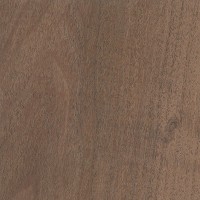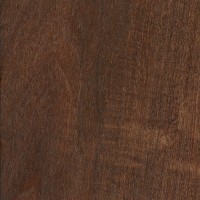 |
Common Name(s): African Mesquite Scientific Name: Prosopis africana Distribution: Tropical Africa Tree Size: 100 ft (30 m) tall, 5 ft (1.5 m) trunk diameter Average Dried Weight: 59 lbs/ft3 (945 kg/m3) Specific Gravity (Basic, 12% MC): .78, .95 Janka Hardness: 2,940 lbf (13,080 N) Modulus of Rupture: 18,930 lbf/in2 (130.5 MPa) Elastic Modulus: 2,019,000 lbf/in2 (13.92 GPa) Crushing Strength: 10,650 lbf/in2 (73.5 MPa) Shrinkage: Radial: 2.8%, Tangential: 4.6%, Volumetric: 7.6%, T/R Ratio: 1.6 |
Color/Appearance: Heartwood tends to be a reddish brown, which darkens with age. Sapwood is a yellow/tan color.
Grain/Texture: African Mesquite has a medium to coarse texture and open pores, with a slight natural luster. Clear portions of the trunk tend to have straight, wavy, or interlocked grain.
Endgrain: No data available. Most likely similar to Black Mesquite.
Rot Resistance: African Mesquite is considered durable to very durable regarding decay resistance, and also has good resistance to insect attack.
Workability: African Mesquite contains silica, and can have a moderate blunting effect on cutting edges. Clear and straight grained Mesquite is easy to work with hand and machine tools, but areas of irregular or interlocked grain can pose a challenge. Glues, turns, and finishes well.
Odor: African Mesquite is said to have a fragrant odor while being worked.
Allergies/Toxicity: Woods in the Prosopis genus have been reported to cause skin irritation. See the articles Wood Allergies and Toxicity and Wood Dust Safety for more information.
Pricing/Availability: Seldom if ever available in the United States. No pricing data available.
Sustainability: This wood species is not listed in the CITES Appendices or on the IUCN Red List of Threatened Species.
Common Uses: Flooring, turned objects, boatbuilding, cabinetry, and furniture.
Comments: None.
Scans/Pictures: There are currently no pictures of this exact wood species, but a similar species within the Prosopis genus is being substituted (P. nigra). If you’d like to contribute a wood sample of this specific species to be scanned, (even small pieces of veneer can be sent), please use the contact form.
 |
 |





Regarding specifically the 9:51 31Dec pic, I’d rather say its Guibourtia coleosperma (African Rosewood), but perhaps I’m wrong.
These are samples of iron wood
I have more pictures if needed
I have a better picture of these is more reddish than than what you post
while searching for the name of the wood of my west african drum (djembe, probably from Ivory Coast), I found your website.
I think my drum is made out of African Mesquite (Prosopis Africana),
what they call ‘Bois du Forgeron’, Numu Yiri (in Malinke, language of
the people from Mali) means also bois du forgeron, another name is Iron
Wood, among other local names.
I hope the photoes help your collection, I don’t have raw pieces of this wood.
djembe shell outside
sorry, the photos 2 and 3 are not sharp.
djembe foot outside
photo 3
photo 2
while searching for the name of the wood of my west african drum (djembe, probably from Ivory Coast), I found your website.
I think my drum is made out of African Mesquite (Prosopis Africana), what they call ‘Bois du Forgeron’, Numu Yiri (in Malinke, language of the people from Mali) means also bois du forgeron, another name is Iron Wood, among other local names.
I hope the photoes help your collection, I don’t have raw pieces of this wood.